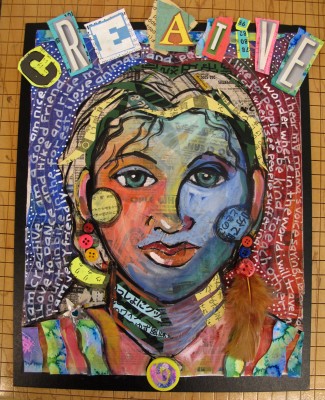As a teaching artist for the state of Hawaii, I create arts integrated unit plans for elementary and middle school students. In designing lessons for kids, I’m always thinking of how to engage them in ways that are high on the fun meter while skill-building in the chosen areas of study. An added benefit is that I get to try out new ideas and play like a kid; I feel like a mad scientist experimenting with this material and that technique until I come up with something I love and I think they will love doing too. This is one of those projects, currently under way at an arts integrated elementary school on Maui. The kids have collaged their boards with a variety of printed papers and will begin drawing on them in the next session. In my demo, I outlined the face with ink, painted the interior with tempera, adding 3D collage elements to finish it off. The children will then write an “I Am” poem in the background behind the portrait. I’m thrilled with the way mine turned out, and can’t wait to see what the kids come up with! I can also envision using this idea for a visual journal page!
Here are some student samples. We decided not to write an “I Am” poem in the background of the piece. It was too complicated for a number of reasons, but they did think of an adjective to describe an aspect of their personality, cut the letters from a magazine and glue them onto the portrait. Before launching into the collage, however, we had two lessons in portrait drawing. These were their practice sketches, and they were done on 1/4 sheets of 9×12 sketch paper. Small. The first lesson focused on realistic proportions, the second on abstracted portraits. Picasso was our exemplar for the second lesson. When the time came to work on the collage portrait, I gave them a choice as to whether they created a realistic or an abstract portrait. Here are the basic steps for the collage portrait…
1. Use a piece of 9×12 chipboard from the back of an old sketch or watercolor pad as your collage foundation.
2. Collect a variety of pages from old books and put a container on each table along with small cups of watered down white glue and brushes.
3. Have students tear the papers into pieces and glue to the chipboard. Put a top coat of glue on to seal when finished. Let dry.
4. Draw portrait on top of the printed paper collage. (Erasing is not a problem because the extra top coat of glue protects the collage papers from being abraded.)
5. Outline with Sharpie.
6. Paint with tempera. If it’s too thick they’ll lose the printed collage papers beneath. If the paint is too thin the printed papers will compete with portrait. Let dry.
7. Sharpie over any lines that got covered with paint.
8. Add 3D collage elements: beads, buttons, feathers etc.
9. Glue descriptive word to portrait
If you try this in your classroom, please post some of your favorites. Iʻm sure weʻd all love to see the results. Have fun!




